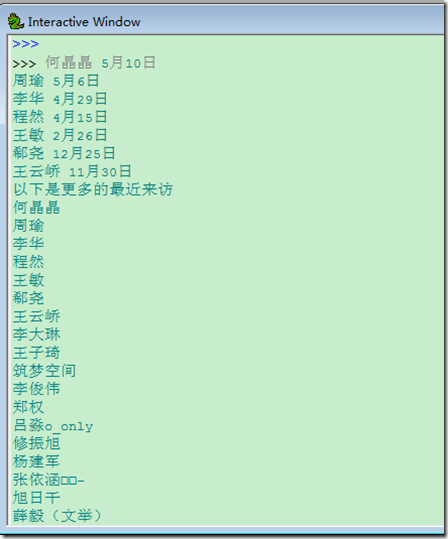Python的requests初步使用
发布于 2016-01-04 09:53:31 | 165 次阅读 | 评论: 0 | 来源: PHPERZ
Requests Python 的 HTTP 客户端库
Requests 是一个 Python 的 HTTP 客户端库。
早就听说requests的库的强大,只是还没有接触,今天接触了一下,发现以前使用urllib,urllib2等方法真是太搓了……
这里写些简单的使用初步作为一个记录
一、安装 http://cn.python-requests.org/en/latest/user/install.html#install
二、发送无参数的get请求
|
1
2
3
4
5
6
7
8
9
10
11
12
13
14
15
|
>>> print r.text{ "args" : {}, "headers" : { "Accept" : "*/*" , "Accept-Encoding" : "gzip, deflate" , "Connection" : "close" , "Host" : "httpbin.org" , "User-Agent" : "python-requests/2.3.0 CPython/2.6.6 Windows/7" , "X-Request-Id" : "8a28bbea-55cd-460b-bda3-f3427d66b700" }, "origin" : "124.192.129.84" , } |
三、发送带参数的get请求,将key与value放入一个字典中,通过params参数来传递,其作用相当于urllib.urlencode
|
1
2
3
4
5
|
>>> import requests>>> pqyload = { 'q' : '杨彦星' }>>> r.url |
四、发送post请求,通过data参数来传递,
|
1
2
3
4
5
6
7
8
9
10
11
12
13
14
15
16
17
18
19
20
21
22
23
24
25
26
|
>>> payload = { 'a' : '杨' , 'b' : 'hello' }>>> print r.text{ "args" : {}, "data" : "", "files" : {}, "form" : { "a" : "\u6768" , "b" : "hello" }, "headers" : { "Accept" : "*/*" , "Accept-Encoding" : "gzip, deflate" , "Connection" : "close" , "Content-Length" : "19" , "Content-Type" : "application/x-www-form-urlencoded" , "Host" : "httpbin.org" , "User-Agent" : "python-requests/2.3.0 CPython/2.6.6 Windows/7" , "X-Request-Id" : "c81cb937-04b8-4a2d-ba32-04b5c0b3ba98" }, "json" : null, "origin" : "124.192.129.84" , }>>> |
可以看到,post参数已经传到了form里,data不光可以接受字典类型的数据,还可以接受json等格式
|
1
2
3
|
>>> payload = { 'a' : '杨' , 'b' : 'hello' }>>> import json |
五、发送文件的post类型,这个相当于向网站上传一张图片,文档等操作,这时要使用files参数
|
1
2
3
|
>>> files = { 'file' : open ( 'touxiang.png' , 'rb' )}>>> r = requests.post(url, files = files) |
5.1 定制headers,使用headers参数来传递
|
1
2
3
4
5
6
|
>>> import json>>> payload = { 'some' : 'data' }>>> headers = { 'content-type' : 'application/json' }>>> r = requests.post(url, data = json.dumps(payload), headers = headers) |
六、响应内容
6.1 响应状态码
r = requests.get('http://httpbin.org/get')
print r.status_code
6.2 响应头
|
1
2
|
>>> print r.headers{ 'content-length' : '519' , 'server' : 'gunicorn/18.0' , 'connection' : 'keep-alive' , 'date' : 'Sun, 15 Jun 2014 14:19:52 GMT' , 'access-control-allow-origin' : '*' , 'content-type' : 'application/json' } |
也可以取到这个个别的响应头用来做一些判断,这里的参数是不区分大小写的
r.headers[‘Content-Type’]
r.headers.get(‘Content-Type’)
6.3 响应内容,前面已经在应用了
r.text
r.content
七、获取响应中的cookies
|
1
2
3
|
>>> r.cookies[ 'BAIDUID' ]'D5810267346AEFB0F25CB0D6D0E043E6:FG=1' |
也可以自已定义请求的COOKIES
|
1
2
3
4
5
6
7
8
9
10
11
|
>>> cookies = { 'cookies_are' : 'working' }>>> r = requests.get(url,cookies = cookies)>>> >>> print r.text{ "cookies" : { "cookies_are" : "working" }}>>> |
cookies还有很多,因为目前我也还不是很多,以后再扩充吧
八、使用timeout参数设置超时时间
>>> requests.get('http://github.com', timeout=1)
<Response [200]>
如果将时间设置成非常小的数,如requests.get('http://github.com', timeout=0.001),那么如果在timeout的时间内没有连接,那么将会抛出一个Timeout的异常
九、访问中使用session
先初始化一个session对象,s = requests.Session()
然后使用这个session对象来进行访问,r = s.post(url,data = user)
参考文章 http://blog.csdn.net/iloveyin/article/details/21444613 基本上都是从这扒的代码
以下通过访问人人网来获取首页中的最近来访问,然后再访问查看更多的来访来读取更多的最近来访
更多的来访就是以带session的访问http://www.renren.com/myfoot.do
|
1
2
3
4
5
6
7
8
9
10
11
12
13
14
15
16
17
18
19
20
21
22
23
24
25
26
27
28
29
|
#coding:utf-8import requestsimport reuser = { 'email' : 'email' , 'password' : 'pass' }s = requests.Session()r = s.post(url,data = user)html = r.textvisit = []first = re. compile (r '</span><span class="time-tip first-tip"><span class="tip-content">(.*?)</span>' )second = re. compile (r '</span><span class="time-tip"><span class="tip-content">(.*?)</span>' )third = re. compile (r '</span><span class="time-tip last-second-tip"><span class="tip-content">(.*?)</span>' )last = re. compile (r '</span><span class="time-tip last-tip"><span class="tip-content">(.*?)</span>' )visit.extend(first.findall(html))visit.extend(second.findall(html))visit.extend(third.findall(html))visit.extend(last.findall(html))for i in visit: print iprint '以下是更多的最近来访'fm = re. compile (r '"name":"(.*?)"' )visitmore = fm.findall(vm.text)for i in visitmore: print i |
